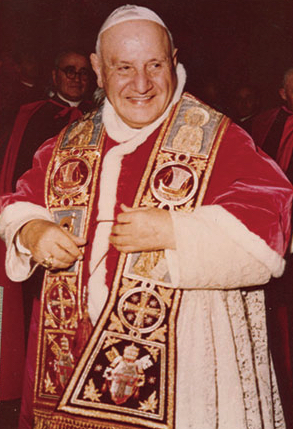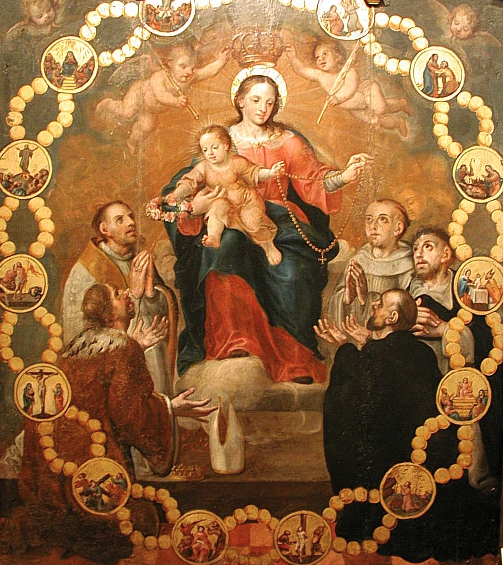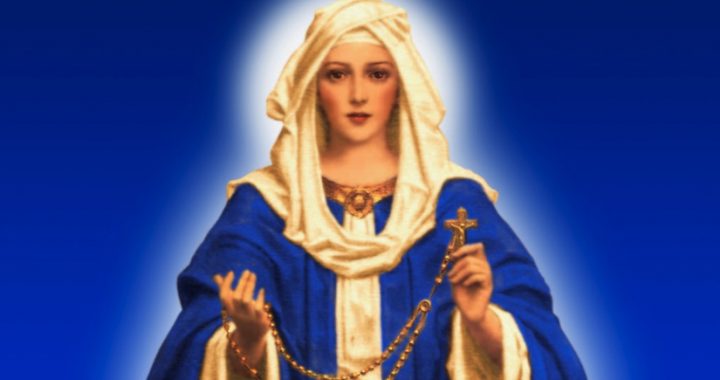With Christ the focus of prayer, the Blessed Virgin teaches us to contemplate His face
(Editor: The Month of October is dedicated to Mary and the Rosary. Today, 7 October, we celebrate the Feast of Our Lady of the Rosary. Read the origins of this feast: Battle of Lepanto)
Padre Pio or Saint Pius of Pietrelcina was known for his great devotion to the Blessed Virgin Mary and fervently prayed her Rosary every day. He had several of the beads within reach so that he could easily pray it anytime, day or night.
One day he discovered the ones he kept under his pillow were not there and called a priest, Fr Onorato of San Giovanni Rotondo, for assistance and famously said, “Young man, get me my weapon, give me my weapon.”
To Padre Pio, born in 1887 and died 81 years later in 1968, the Rosary prayer is a powerful tool against Satan and his demonic minions. But the Italian Franciscan Capuchin priest and mystic was not the first or only Catholic to regard the Rosary as a spiritual weapon against the forces of evil.
Countless Popes since the 13th century up till the present time have similarly hailed the power of the Rosary as such. Pope Pius XI (1922-1939) in his encyclical, Ingravescentibus Malis, called it “a powerful weapon to put the demons to flight”.
In summoning all Catholics to pray the Rosary on 29 Sept 2018, Pope Francis said it “is the weapon against the Great Accuser (Satan) who ‘goes around the world seeking to accuse.’ Only prayer can defeat him.”
The Rosary is among the most powerful prayer that God, through His Mother Mary, has put in our hands to send the devil fleeing in fear in his attempts to disrupt our full Communion with God. It ranks high in the Church’s spiritual armoury, as Pope St John XXIII points out, “The Rosary is the glory of the Roman Church. As an exercise of Christian piety, it takes its place among the faithful after the Mass and the Sacraments.”
But what makes the Rosary prayer so powerful a spiritual weapon that forces demons to tremble in fear and scoot?

With Christ at the centre, heresies are destroyed
The most important point to remember is that every prayer we recite is addressed to God, even if we asked the saints to intercede for us. But Mary’s intercession is special and extraordinary.
And the Rosary prayer the Mother of God gave us is fully Christocentric because she puts her Son, Christ, at its centre and focus. And this is what gives the Rosary its potency.
But we need to step back and journey nine centuries in history to appreciate this fully.
Heresies are false doctrines that contradict Church teachings the devil uses to pollute the minds of Christians. And in the 13th century, the Albigensian heresy wreaked havoc among the faithful in Europe. It got its name from Albi, a city in southern France, where it originated.
The propagators of the heresy were the Cathari, a dualist religious movement there, who taught the falsehood that only the spiritual is good and that everything material is bad. In other words, they were spreading the lie that the human body, which God created, is evil, and every person’s soul is imprisoned in it.
To combat this false teaching, the Spanish priest Dominic Guzman went to France in 1208 to preach against it but his attempts largely fell on deaf ears. Exasperated, he retreated into a forest near Toulouse and entreated God to provide him with the means to overcome the heresy. It was there in his solitude of prayer that the Mother of God appeared to him.
The Virgin Mary instructed Dominic that he must preach her Psalter to succeed against the Albigensian heresy. The Marian Psalter is a meditative prayer the Cistercian monks had then just developed consisting of 150 Hail Marys and 10 Our Fathers.
Read also:
Mary: The Mother God gives the world
Hail, Full of Grace
The power of the Hail Mary
Mary told Dominic her Psalter prayers must be accompanied by stories of Christ’s life – His Incarnation, Death, and triumphant Resurrection – that will debunk the Albigensian heresy. In Dominic’s hands the Psalter, which became known as the Rosary or literary “wreath of roses”, successfully defeated the heresy. It led to countless conversions and miracles.
Centuries later, Pope Leo XIII (1878- 1903), in recalling this remarkable event of Dominic’s, now saint, and the Blessed Virgin Mary’s Rosary, said,
Thanks to this new method of prayer… piety, faith, and union began to return [to France], and the project and devices of the heretics fell to pieces.”
Fr Reginald Garrigou-LaGrange, a respected Dominican theologian of the 20th century, added, “What the word of the preacher was unable to do, the sweet prayer of the Hail Mary did for hearts.”
A simple, effective Gospel that Mary teaches her children
It must be stressed that Our Lady designed the Rosary to teach every human being about her Son – including, more importantly, those who are illiterate and cannot read and write. This group were in large numbers in St Dominic’s time and this is also true today in many parts of the world.
In praying the Rosary, while meditating on the Joyful, Sorrowful, Glorious mysteries – and since 2002 the Luminous mystery that Pope John Paul II added – we learn Christ’s Gospel at Mary’s feet. Every mother knows their children far better than others, but Mary is extraordinarily different and special in knowing Her Son.

As the Mother who bore the Second Person of the Holy Trinity for nine months in her womb, Mary, who was conceived immaculately, had no sin to hamper her ability to know God perfectly. She also raised Jesus and had the privilege of contemplating His face every single day, worshipping Him with all her heart.
Only she knows Christ far more and way above all the theologians and popes put together.
Mary is the perfect disciple of God and no one else in history can teach us more about the Saviour of the world than her. In the Rosary, she showers us with the abundant graces God has endowed her with to help us know Him with increasing fervour each day. Mary teaches all her children, even the illiterate, how to be Her Son’s perfect disciple.
We honour Mary in the Rosary when we welcome the Mother of God into our hearts and homes to illuminate our minds about Her Son Jesus and to give us more of Him. And this is the power behind the Marian Rosary prayer because this is how Mary, until our very last breath, raises us up to be faithful disciples and picks us up each time we fall.
This is why Satan and his forces of darkness are consumed with hatred for Mary and the Rosary. And we have witnessed and are still witnessing his diabolical attempts to discredit and attack her prayer. We have seen great numbers of non-Catholics charge that praying the Rosary is idolatry. Unfortunately, this has also swayed not a few Catholics, especially in their attempts to appease such distractors and as a result slack in praying the Rosary or no longer at all.
But we must soldier on in the face of these adversities and call on Mary, the help of all Christians, to be our shield and protector, just as she did for St Dominic during the Albigensian heresy.
As the great Marian Pope, St John Paul II, entreated all Christians, “Recite the Rosary every day. I earnestly urge Pastors to pray the Rosary and to teach people in their Christian communities how to pray it.”
Read Pope St John Paul II’s encyclical on the Rosary, Rosarium Virginis Mariae
POPES ON THE ROSARY
Pope Francis: The Rosary “is the weapon against the Great Accuser who ‘goes around the world seeking to accuse.’ Only prayer can defeat him.”
Pope Benedict XVI (2005-2013): The Rosary is “the prayer of the Christian who advances in the pilgrimage of faith, in the following of Jesus, preceded by Mary … it is a means given by the Virgin for contemplating Jesus and, meditating on his life, for loving and following him always more faithfully.”
Pope John Paul II (1978-2005): “The Rosary is my favourite prayer … I would therefore ask those who devote themselves to the pastoral care of families to recommend heartily the recitation of the Rosary.”
Pope John Paul I (August 26–September 28, 1978) in Homily in 7 Oct 1973 before he was elected Pope five years later: “The Rosary, a simple and easy prayer, helps me to be a child again, and I am not ashamed of it at all.”
Pope Paul VI (1963-1978): “If evils increase, the devotion of the People of God should also increase … Pray ardently to our most merciful mother Mary by saying the Rosary during the month of October. This prayer is well-suited to the devotion of the People of God, most pleasing to the Mother of God and most effective in gaining heaven’s blessings.”
Pope John XXIII (1958-1963): “The Rosary is a magnificent and universal prayer for the needs of the Church, the nations and the entire world.”
Pope Pius XII (1939-1958): “We do not hesitate to affirm publicly that We put great confidence in the Holy Rosary for the healing of evils of our times.”
Pope Pius XI (1922-1939): “A powerful weapon to put the demons to flight” … “Kings and princes, however burdened with most urgent occupations and affairs, made it their duty to recite the Rosary.”
Pope Benedict XV (1914-1922): “The prayer of the Rosary is perfect, because of the praises it offers, the lessons it teaches, the graces it obtains, and the victories it achieves.”
St. Pius X (1903-1914): “The Rosary is the most beautiful and the richest of all prayers to the Mediatrix of all grace; It is the prayer that touches most the heart of the Mother of God. Say it each day!”
Pope Leo XIII (1878- 1903): “The Rosary is the most excellent form of prayer. It is the remedy for all our evils, the root of all blessings. There is no more excellent way of praying.”
Pope Gregory XVI (1831-1846): “The Rosary is a miraculous means, the most capable one amongst other means, to destroy sin and regain divine grace.”
Pope Innocent XIII (1721-1724): “The Rosary had been instituted by St. Dominic to appease the anger of God and to implore the intercession of the Blessed Virgin Mary.”
Pope Paul V (1605-1621): “The rosary is a treasure of graces”
Pope Gregory XII (1406-1415): “The Rosary is a wonderful instrument for the destruction of sin, the recovery of GOD’s grace, and the advancement of His glory”
Pope Julius III (1550-1555): The Rosary is “the Glory of the Church.”
Pope Adrian VI (1522-1523): “The rosary is the scourge of the devil.”
Pope Leo X (1513-1521): The Rosary “was instituted to oppose pernicious heresiarchs and heresies.”
Pope Sixtus XI (1471-1484): This method of prayer, the Rosary, “redounded to the honour of God and the Blessed Virgin, and was well suited to obviate impending dangers”
Pope Gregory XI (1370- 1378): “The Rosary is this wonderful means to destroy sin and recover grace.”
Pope Benedict XII (1334-1342): “The Rosary is a sovereign remedy to errors and vices.”
Pope Urban IV (1261-1264): “Every day the Rosary obtains fresh boom for Christianity … There is a pious rite which, to be protected against the dangers threatening the world, consists in reciting … the Ave Maria, as many times as the Psalms of David, while saying before each decade the dominical prayer… With our Apostolic authority, we approve this psalter of the Virgin.”
